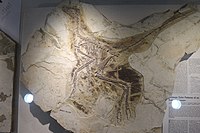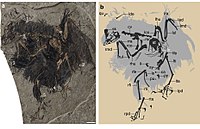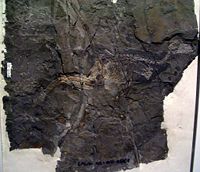From Wikipedia, the free encyclopedia
Wikipedia list article
There have been some discoveries of unusually well-preserved fossil dinosaur specimens which bear remnants of tissues and bodily structures. All organic tissue usually decays too quickly to enter the fossil record, unlike more mineralised bones and teeth.
Ornithischians [ ] Basal ornithischians [ ] Hadrosaurs [ ] Ceratopsians [ ] Thyreophorans [ ] Saurischians [ ] Maniraptoriformes [ ]
Nickname
Catalogue Number(s)
Institution(s)
Taxon
Age
Unit
Country(s)
Notes
Images
, , and
Institute of Vertebrate Paleontology and Paleoanthropology , , and the Beijing Museum of Natural History
Anchiornis huxleyi Oxfordian
Tiaojishan Formation
China
Many specimens of Anchiornis have been found, but a majority have not been described
IVPP 21711
Institute of Vertebrate Paleontology and Paleoanthropology
Cruralispennia multidonta Hauterivian
Huajiying Formation
China
It is a small Enantiornithine bird, it preserves pigment
PMoL-B00175
Paleontological Museum of Liaoning
Caihong juji Oxfordian
Yanliao Biota
China
The small bird possess pigments that might indicate black and iridescent colors.
Inkayacu paracasensis Divisaderan -Tinguirirican
Peru
A Fossil Penguin; pigments are preserved on this specimen.
see Specimens of Archaeopteryx
British Museum , the Maxburg Museum , among others
Archaeopteryx lithographica Tithonian
Solnhofen Limestone
Germany
see Specimens of Archaeopteryx
Natural History Museum, Berlin and the Wyoming Dinosaur Center
Archaeopteryx siemensii
Tithonian
Solnhofen Limestone
Germany
UFrJ-Dg 031
Federal University of Rio de Janeiro
Cratoavis cearensis Aptian
Crato Formation
Brazil
It is a small Enantiornithine bird, it preserves a pygostyle and body feathers.
FMHH PA 778
Field Museum of Natural History
Nahmavis grandei Eocene
Green River Formation
USA
This bird comes from the Eocene Lagerstätte of the Green River in Wyoming.
Chinese Academy of Geological Sciences
Jinfengopteryx elegans Aptian
Huajiying Formation
China
A Troodontid Dinosaur with extensive feather preservation.
IVPP V24194
Institute of Vertebrate Paleontology and Paleoanthropology
Jinguofortis perplexus Barremian
Dabeigou Formation
China
A Pygostylian Bird with feather preservation.
Geological Museum of China
Changchengornis hengdaoziensis Barremian -Aptian
Yixian Formation
China
A Confuciusornithidae Bird with feather preservation.
Compsognathidae [ ] Tyrannosauroidea [ ] Abelisaurs [ ] Sauropodomorphs [ ] See also [ ] References [ ]
^ Witton, Mark (2015-12-24). "Mark Witton.com Blog: Dinosaur scales: some thoughts for artists" . Mark Witton.com Blog . Archived from the original on June 18, 2021. Retrieved 2021-06-25 .^ "Leonardo" . Great Plains Dinosaur Museum and Field Station . Great Plains Dinosaur Museum and Field Station. Retrieved 28 May 2021 .^ "World's Most Complete Mummified Dinosaur Moves into The World's Largest Children's Museum | The Children's Museum of Indianapolis" . www.childrensmuseum.org . Children's Museum of Indianapolis. Retrieved 28 May 2021 .^ Benson, Rod. "Montana Earth Science Picture of the Week" . formontana.net . formontana.net. Retrieved 28 May 2021 . ^ "Zuul, Destroyer of Shins" . Royal Ontario Museum . Royal Ontario Museum. Retrieved 29 May 2021 .^ Tarlach, Gemma. "Meet Zuul crurivastator: I Ain't 'Fraid Of No Ankylosaur" . Discover Magazine . Discover Magazine. Retrieved 29 May 2021 . ^ Arbour, Victoria M.; Evans, David C. (2017). "A new ankylosaurine dinosaur from the Judith River Formation of Montana, USA, based on an exceptional skeleton with soft tissue preservation" . Royal Society Open Science . Royal Society Publishing. 4 (5): 161086. doi :10.1098/rsos.161086 . PMC 5451805 PMID 28573004 . Retrieved 29 May 2021 . ^ Greshko, Michael (2018-12-17). "New species of incredible 'living tank' dinosaur unveiled" . National Geographic . National Geographic. Retrieved 29 May 2021 . ^ Xu, X.; Wang, K.; Zhang, K.; Ma, Q.; Xing, L.; Sullivan, C.; Hu, D.; Cheng, S.; Wang, S.; et al. (2012). "A gigantic feathered dinosaur from the Lower Cretaceous of China" (PDF) . Nature . 484 (7392): 92–95. doi :10.1038/nature10906 . PMID 22481363 . S2CID 29689629 . Archived from the original (PDF) on 17 April 2012. ^ Cerroni, M. A.; Canale, J. I.; Novas, F. E. (2020). "The skull of Carnotaurus sastrei Bonaparte 1985 revisited: insights from craniofacial bones, palate and lower jaw". Historical Biology . 33 (10): 2444–2485. doi :10.1080/08912963.2020.1802445 . S2CID 225374445 . ^ Hendrickx, Christophe; Bell, Phil R. (August 2021). "The scaly skin of the abelisaurid Carnotaurus sastrei (Theropoda: Ceratosauria) from the Upper Cretaceous of Patagonia". Cretaceous Research . 128 : 104994. doi :10.1016/j.cretres.2021.104994 . ^ Gallagher T, Poole J, Schein JP (2021). "Evidence of integumentary scale diversity in the Late Jurassic sauropod Diplodocus sp. from the Mother's Day Quarry, Montana" . PeerJ . 9 : e11202. doi :10.7717/peerj.11202 PMC 8098675 PMID 33986987 .
Categories :
Lists of dinosaur specimens Dinosaur-related lists Hidden categories:
Articles with short description Short description is different from Wikidata


















